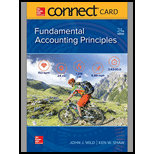
Liabilities Section in
The Liabilities section of balance sheet consists of all outside liabilities and is divided in to two parts i.e. current liabilities and long term liabilities. These are discussed as under:
Current liabilities: These are those liabilities which need to be paid off within twelve months from the date of preparation of financial statements. These liabilities includes the liabilities which mainly arises from the operations of the business like Accounts payable, expense payable, etc.
Long term liabilities: The Liabilities which has been taken for a long time generally more than an year shall be termed as long term liabilities. These are the liabilities which are taken for long term financing of the business and includes Bonds payable, long term notes payable, etc.
The Preparation of Liabilities section of Balance sheet.
Want to see the full answer?
Check out a sample textbook solution
Chapter 14 Solutions
Connect Access Card For Fundamental Accounting Principles
- Job 528 was one of the many jobs started and completed during the year. The job required $11,200 in direct materials and 40 hours of direct labor time at a total direct labor cost of $12,600. If the job contained five units and the company billed at 65% above the unit product cost on the job cost sheet, what price per unit would have been charged to the customer?arrow_forwardCalculate the net cash provided by operating activities of this financial accounting questionarrow_forwardgiven answer of this General accounting questionarrow_forward
- Burson Enterprises' May 31 bank reconciliation shows deposits in transit of $850. The general ledger Cash in Bank account shows total cash receipts during June of $48,500. The June bank statement shows total cash deposits of $44,300 (including $1,500 from the collection of a note; the note collection has not yet been recorded by Burson). What amount of deposits in transit should appear in the June 30 bank reconciliation? Helparrow_forwardWhat should be the adjusted cash balancearrow_forwardHii, tutor give me Answerarrow_forward
- General Accountingarrow_forwardJuno Manufacturing produces lamps that require 2.8 standard hours per unit at an hourly rate of $14.00 per hour. If 5,800 units required 15,900 hours at an hourly rate of $13.60 per hour, determine the following: a) Direct labor rate variance b) Direct labor time variance c) Total direct labor cost variancearrow_forwardprovide correct answer of this General accounting questionarrow_forward
- 4 POINTSarrow_forwardIn the month of September, a department had 9,500 units in beginning work in process that were 60% complete. During September, 28,500 units were transferred into production from another department. At the end of September, there were 5,500 units in ending work in process that were 50% complete. Materials are added at the beginning of the process, while conversion costs are incurred uniformly throughout the process. A. The equivalent units of production for materials in September were __. B. The equivalent units of production for conversion costs for September were __.arrow_forwardAnswer ?arrow_forward

 AccountingAccountingISBN:9781337272094Author:WARREN, Carl S., Reeve, James M., Duchac, Jonathan E.Publisher:Cengage Learning,
AccountingAccountingISBN:9781337272094Author:WARREN, Carl S., Reeve, James M., Duchac, Jonathan E.Publisher:Cengage Learning, Accounting Information SystemsAccountingISBN:9781337619202Author:Hall, James A.Publisher:Cengage Learning,
Accounting Information SystemsAccountingISBN:9781337619202Author:Hall, James A.Publisher:Cengage Learning, Horngren's Cost Accounting: A Managerial Emphasis...AccountingISBN:9780134475585Author:Srikant M. Datar, Madhav V. RajanPublisher:PEARSON
Horngren's Cost Accounting: A Managerial Emphasis...AccountingISBN:9780134475585Author:Srikant M. Datar, Madhav V. RajanPublisher:PEARSON Intermediate AccountingAccountingISBN:9781259722660Author:J. David Spiceland, Mark W. Nelson, Wayne M ThomasPublisher:McGraw-Hill Education
Intermediate AccountingAccountingISBN:9781259722660Author:J. David Spiceland, Mark W. Nelson, Wayne M ThomasPublisher:McGraw-Hill Education Financial and Managerial AccountingAccountingISBN:9781259726705Author:John J Wild, Ken W. Shaw, Barbara Chiappetta Fundamental Accounting PrinciplesPublisher:McGraw-Hill Education
Financial and Managerial AccountingAccountingISBN:9781259726705Author:John J Wild, Ken W. Shaw, Barbara Chiappetta Fundamental Accounting PrinciplesPublisher:McGraw-Hill Education





